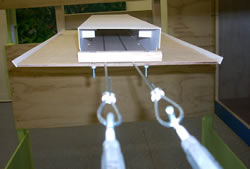The weight, torsional stiffness, and especially the shape of the cross section of a suspension bridge deck determine the stability of the bridge in strong winds. Subtle changes to the cross section of the bridge have a big effect on how stable the bridge is in strong winds.
The importance of cross-sectional shape on bridge stability during winds was demonstrated in 1940 when the newly completed Tacoma Narrows Bridge in Washington State collapsed on a moderately windy day (about 40 miles per hour or 64 kilometers per hour). One model on display is a scale model of the deck of the Tacoma Narrows Bridge that collapsed.

The other model is a modern design using today's knowledge of aerodynamics. Both small-scale models of the bridge decks are equally stocky in cross section, with the same height and width. But if the wind is blowing, the model at left (Tacoma Narrows Bridge) will probably be twisting, sometimes violently; while the model at right, with a shape that responds to the wind in a stable way, may bounce a little because of gusts but quickly "calms down." Even if you push or tap the model on the right, it will return to its original position. These models show how subtle differences in the shape of bridge decks can have a significant effect on how bridges respond to strong winds.
Because of the small scale of these models, they simulate (with some exaggeration) the behavior of full-size bridge decks exposed to a wind speed about 10 times greater. For example, when the wind speed here is 5 miles per hour (8 kilometers per hour), the models simulate the effect on full-size bridge decks exposed to winds of about 50 miles per hour (80 kilometers per hour).
Above photograph by James Bashford. Courtesy of the Harbor History Museum, Gig Harbor, Washington.
Examples of Bridge Cross Sections
|

Tacoma Narrows Bridge, cross-section of deck.
|
|

Modern aerodynamically designed bridge, cross-section of deck.
|
Bridge Deck (Prototype) Models
 |
Model representing a section of the Tacoma Narrows Bridge Model
|
 |
Model representing a modern aerodynamically designed bridge (specimen tested upside-down for convenience) |